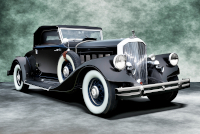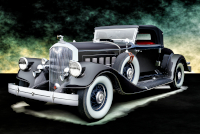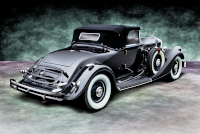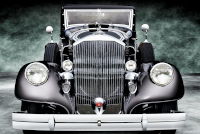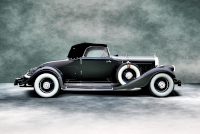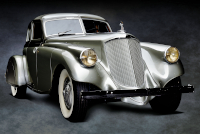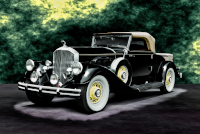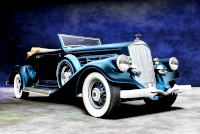Location:
Radnor Hunt Concours d'Elegance, 2023
Owner: Elaine & Tony Lang | Hanover, Ontario, Canada
Prologue:
The rain show... Another late summer soak, so I used the rain as extra patina. Not sustained in the survey perspectives where I can more easily illustrate clean surfaces, it would be folly to remove the natural water beads from these portraits. And less the accolade for the owners who set the car out in the elements. All the same, I grimaced at the work involved, and this piece lingered in production for a long minute.
Most sources claim there are three surviving cars of five Model 1242 roadsters produced. We've now seen two of them, the first dating back to 2008 (chassis #3100014). Perhaps tough to claim that the model is so rare, but such is the way of special automobiles to show up in photographs rather frequently. (And in another 16 years perhaps we'll spot the third.) But this car is the lone addition to the portfolio from a concours that fielded a Pierce-Arrow class, only to see the weather wash most of it away.
- - - - - - - - - -
► Image Source: Nikon D750 (24.3 MP)
References:
- Ralston, Marc. "Pierce-Arrow" A.S. Barnes & Co., Inc., San Diego, CA. 1980, page 178-179, 232
- Automobile Quarterly, Volume 28, Number 4, Fourth Quarter 1990, "The Last Years of Luxury" by John C. Meyer III, The Kutztown Publishing Company, Inc., Kutztown, PA, page 73, 92
- Pierce-Arrow Custom Salon Twelves Sales Brochure, 1933, Buffalo, New York: Vintage source for technical detail and fact-checks.
- The Lang Collection: Elaine and Tony Lang maintain an online register of their collection, including this Model 1242.
- RM Sotheby's: The listing from RM's 2019 Amelia Island auction.
- Christie's: Additional details sourced from an older auction listing, about the time that the car moved from Florida to Canada.
With news stirred by land speed records and the Silver Arrow debut in New York, a car such as this Model 1242 evokes a sense of quiet superiority that had been absent from the marque for perhaps a decade. There is nothing so remarkable in the body style—a two-door roadster—but an understanding that Pierce-Arrow, now back on its game, is ready to lead the industry with enthusiasm. (Or at least with the stern resolve that admits no fault in over-engineering, over-building, and over-testing its products.)
To say a word more, the 1242 is not a classic that grabs at first glance, yet it is just behind the Silver Arrow show car in exclusivity. Equal in production numbers (five) and those that survive (three), the 1242 is a gentle style statement, and one of the few open, two-place cars Pierce-Arrow developed. Even the term, 'roadster,' is an anomaly. Pierce-Arrow clientele kept conservative motoring values, and the board tried not to upset that cautiously American apple cart. 1933 is a good year, however, what with the Silver Arrow and land-speed records, so the Model 1242 V-12 roadster is a rather fine commemoration of that spirit.
Pierce-Arrow Return to Independence
In 1933, Pierce-Arrow return to building automobiles in the manner they see fit—obsessively, with an optimistic regard for both the public's ability to appreciate their obsession, and the associated cost. Pierce-Arrow are also about to regain their independence. For the past three years, Studebaker have injected into Pierce-Arrow nearly $3 million in cash out of their own $36 million reserves, (the figure with which they entered the Depression era), enough to allow the Buffalo factory to upgrade, re-tool, and begin building the modernized designs that are long overdue.
But all too soon, by March of 1933, Studebaker will default on $6 million in loans, having allowed its reserves to dwindle in the wake of the Depression. So it is that Studebaker rose to fourth position in the American auto market at the time of Pierce-Arrow's acquisition, (which is really first place behind the big three), only to run into receivership a few years later. Both companies will earn a few extra years after their forthcoming divorce. Studebaker even hobbles into the post-War era. But if it is any indication of economic conditions in America, Studebaker's president, Albert Russell Erskine, will succumb to the psychological toll and commit suicide in June.
The Pierce-Arrow story of 1933 is a familiar Depression era tale. Financial stresses come to a boil. Large organizations reach their ends. And from those ends unfold new beginnings. Automobile Quarterly write that, by August, "Buffalo businessmen led by George Rand of the Marine Midland Bank chain secured the Pierce-Arrow Company with a million dollars in cash, and once again the automaker was independent." So Pierce-Arrow regain independence, but then how they rebound from bankruptcy is a rather impressive story in itself.
First, the company embarked on a land speed record-breaking campaign with Ab Jenkins and the new 462 cubic inch V-12, beginning in late September 1932 and continuing through 1934. Jenkins' team topped out at an average of 127 miles per hour over 3,053.3 miles, setting 14 world unlimited class records, 14 new international class records, and 38 American class records. This record-breaking campaign provided Pierce-Arrow the sort of credentials the company originally sought in the Glidden Tour, a means to verify that it built the best automobile available, and firepower for its advertisers, the media, and the dealer network.
Second, Pierce-Arrow built the Silver Arrow show car. Powered by the record-breaking V-12, Philip O. Wright's design combined multiple trends in streamlining for the first time in a single exercise.
Motor: 7,570 cc (462 cubic inch) 80° V-12, cast-iron block | 88.9 mm x 101.6 mm (3½" x 4") | 6.1:1 compression | Motor #355193
Valvetrain: L-head, 2 valves per cylinder, with self-adjusting hydraulic tappets developed and patented by Carl Voorhies
Voorhies developed and patented the self-adjusting tappet in 1932, but 1933 is the first year Pierce-Arrow brought the innovation to the production line. Pierce-Arrow machined the valve clearance to within .0002 inches. A full-flow oil cleaner and temperature regulator exchanges heat with engine cooling water to control the oil used in the hydraulics. Such is the level of design and precision manufacturing Pierce-Arrow maintained, the product of millions invested in facilities despite the Depression.
Aspiration: Stromberg dual downdraft carburetor, twin-coil Delco-Remy ignition
Pierce-Arrow write of their intake and ignition system, "Carburetor choke and heat control valves are fully automatic, fully self-adjusting from the moment the engine fires. To start the engine, the driver of the modern Pierce-Arrow need only throw the automatic starter and ignition switch."
Power: 175 bhp @ 3,400 rpm
All 1933 motors improve power output owing to a larger fuel manifold, new Stromberg carburetors, and an increased compression ratio of 6:1.
Drivetrain: 3-speed synchromesh gearbox, rear-wheel drive, with built-in freewheeling unit
The 1933 Pierce-Arrow debuted Stewart-Warner power brakes. As Ralston notes, in this system the brake pedal provides only two inches of travel and does not apply any brake pressure directly to the four-wheel mechanical brakes. All of the power comes from the rotation of the drive shaft applied through cables to the four brake shoes. The brake pedal is a governor for the system. He notes this system is similar to that used by Rolls-Royce and other European automobile manufacturers, and that "no other American-built car used this system."
Front Suspension: solid axle, semi-elliptic leaf springs, friction dampers
Rear Suspension: live axle, semi-elliptic leaf springs, friction dampers
At the rear, Pierce-Arrow use a hypoid axle with drive-through torque arm to control movement. The hypoid gear is a bevel type that does not align with the center of the mesh gear. This offset arrangement requires a hyperboloid-shaped gear, as opposed to conical. Pierce-Arrow describe the configuration as a "silent hypoid" and suggest that it gives "Pullman riding qualities," presumably referring to Pullman railway coaches of the period.
Architecture: steel ladder frame chassis with steel body over wood frame | Body #537P
Pierce-Arrow describe the chassis as "deep channel box-girder side members, cross braced with boxed bridging members."
Wheelbase: 3,479.8 mm (137 inches)
Etymology:
For one brief moment, Pierce-Arrow etymology makes (some) sense. In 1933, the first numbers in the designation denote the cylinders, and the latter numbers pertain to the wheelbase. Now all is not completely without idiosyncrasy. The Model 836 is an 8-cylinder available with a 136-inch wheelbase chassis (or a larger 139-inch wheelbase), and the Model 1236 is a V-12 available with the same 136-inch wheelbase chassis (or a 139-inch wheelbase). Conversely, the more powerful Model 1242 uses as its chassis reference the larger available wheelbase, at 142 inches, whereas one could also order a 137-inch wheelbase chassis. And the Model 1247 is simply the big V-12 with a 147-inch wheelbase chassis.
So the convertible coupe roadster is a Model 1242, though the car uses the 137-inch wheelbase chassis. For all intents and purposes, Pierce-Arrow could have designated the car the Model 1237 in keeping with the formula used for the straight 8-cylinder and less powerful V-12. But the company probably wanted to distance the models with the more powerful 462 cubic inch V-12 from the Model 1236, which uses the older 429 cubic inch V-12. In that case, they skipped 37 and picked 42 instead.
Figures:
Ralston notes that Pierce-Arrow produced 2,152 cars for 1933. Of these, the Model 1242 lands at the upper end of the range. RM notes that the 1242 series includes 118 cars, and that of those cars, Pierce-Arrow built approximately five convertible coupe roadsters. Three of those five cars survive. Of those three survivors, we've now profiled two, #3100006 and #3100014. The third is a deep evergreen car featured in Michael Furman's first photo-essay, "Motorcars of the Classic Era." That chassis is sleek, with a single spare fixed in the continental position (on the rear deck) in lieu of side-mount spares.
Value:
Chassis #3100006 sold at RM Sotheby's Amelia Island auction in 2019 for $290,000.
Adaptive Streamlining: Design Evolution at the Height of Classic Era Pierce-Arrow Cars
In 1933, Pierce-Arrow reconfigure the integrated headlamp first conceived by Herbert Dawley for the 1914 model year. The unit extends the headlamp pod in a gentle curve complementary to the fender's compound arc. This alteration creates a pleasingly sleek shape that feels more compact and natural, a wind-adaptive update. The headlamp units are new as well, with bulbous lenses more ocular in shape. Even if the integrated (and patented) design were innovative in the antique era, the original incarnation did seem a bit Sid the Sloth when viewed head-on. This iteration, produced from 1933 to 1935, is perhaps best. (In 1936, Pierce-Arrow will narrow the headlamps and integrate the running lights within a more complex shroud, creating a tubular dual headlamp cluster.)
Also updated for 1933 is the running gear, which in the front adds skirts to the fenders. The flowing line from the front chassis rail, out over the tyre, up and around the wheel arch, into the sweeping skirt is perfectly proportioned. The shape is similar to the new 1933 Packard Tenth Series, yet lithe in comparison because it maintains a continuous curve, whereas Packard introduces a scallop point at the low interior apex of the skirt. Here, Pierce-Arrow evoke a continental influence, a subtle reference to the marque's awareness of the European method.
The 1933 windscreen sits at a slight angle and the radiator unit is a more definitive vee. Both updates follow trends in the luxury segment, particularly those cues common to LeBaron, a coachbuilder never so much ostentatious as deft in selecting a generally pleasing line. But the convertible coupe body is very well rounded through the tail, a true roadster in its attention to sensuous caudate curvature. With so few of these V-12 roadsters produced, this car is a true luxury confection along the lines of a Packard 734, though entirely more refined.
Steel Grain: Comments on the Pewter and Blue Paint
The livery uses pewter with a very fine flake to carry the curves, accented by a nautical blue on the binding, wheels, and undercarriage. Red interior pops some contrast into the composition, evident in our left quarter perspective. These colors hale from the early 1990s when the late John Dietz, Jr. (known as Jack) restored the car for William Lassiter. I appreciate the palette, this silver-blue combination that might otherwise be undone by a fresh restoration. I recently photographed an Auburn V-12 boattail speedster with a similar palette in reverse, a strong nautical blue with silver accents that had also been conceived in the 90s. The feeling I take from each of these cars is the same, strange nostalgia for the early 1990s period when metallic flake reached the end of fashion. These were class colors for the time, a candied version of silver paired with the shade of blue found in a dark sky. Or in this case, a touch of green for nautical effect. But the paint creates a host of reflection and curvature that otherwise would not emerge with the same flair.
Period Comparison: Comparing Two of the Surviving Model 1242 Roadsters
At a glance, #3100006 and #3100014 look quite different. Not only the livery and treatment of the spares, but the tyres are different. This pewter and blue car wears a narrower Denman-type whitewall that does not seem to fill the wheel arches as much as the B.F. Goodrich Silvertown worn by the black example. At the same left quarter perspective, the pewter car appears slightly more antiqued, whereas the black car seems stockier. Wheels and tyres so often make a difference, in this case changing the musculature of the rare Pierce-Arrow roadster.
Archer Apprentice: Quirks of the Archer Mascot
See the chassis #3100014 profile for a description of 1933's elevated tireur d'arc sculpture. On chassis #3100006, the archer might have lost his original bow and arrow. While his sculptural form is beautiful, his hunting kit may be a replacement—the arrow a touch bent and the bow devoid of its typically elegant arc, more closely resembling the line of the previous mascot incarnation seen from 1928 to 1932. On this Model 1242, a head-on view also shows a deviation in mounting, where this fellow is about to fire off the starboard bow. (Pedestrians beware.) For this reason, I did not focus on the archer too closely, but appreciate the quirk just the same.
Last Updated: Mar 26, 2025

